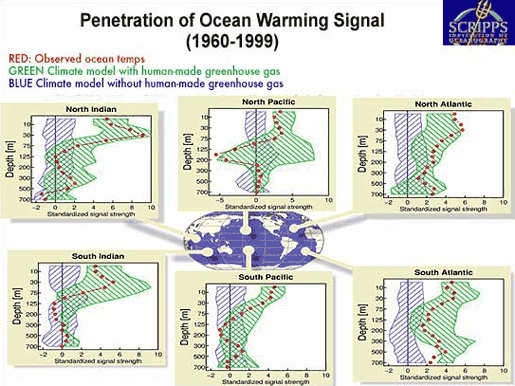Why ocean heat can’t drive climate change, only chase it
What the science says...
| Select a level... |
 Basic
Basic
|
 Intermediate
Intermediate
| |||
|
Oceans are warming across the globe. In fact, globally oceans are accumulating energy at a rate of 4 x 1021 Joules per year - equivalent to 127,000 nuclear plants (which have an average output of 1 gigawatt) pouring their energy directly into the world's oceans. This tells us the planet is in energy imbalance - more energy is coming in than radiating back out to space. |
|||||
Climate Myth...
It's the ocean
"These small global temperature increases of the last 25 years and over the last century are likely natural changes that the globe has seen many times in the past. This small warming is likely a result of the natural alterations in global ocean currents which are driven by ocean salinity variations. Ocean circulation variations are as yet little understood. Human kind has little or nothing to do with the recent temperature changes. We are not that influential." (William Gray)
The notion that the ocean is causing global warming is ruled out by the observation that the ocean is warming (Levitus 2005). Internal climate changes such as El Nino and thermohaline variability stem from transfers of heat such as from the ocean to the atmosphere. If the ocean was feeding atmospheric warming, the oceans would be cooling.
Other studies
In fact, ocean observations confirm both global warming and its cause. Barnett et al. 2005 compares observations of ocean temperatures to results from the Parallel Climate Model (PCM) and finds "model-produced signals are indistinguishable from the observations". This suggests "the observed ocean heat-content changes are consistent with those expected from anthropogenic forcing, which broadens the basis for claims that an anthropogenic signal has been detected in the global climate system."

Warming in the pipeline
The other consequence of the warming ocean is it means there is additional "warming in the pipeline". Even if CO2 emissions were to start falling now, we already face further global warming of about another half degree by the end of the 21st century (Meehl et al. 2005).
Last updated on 25 October 2016 by John Cook. View Archives































 Arguments
Arguments




































There are various independent lines of empirical evidence that this is happening. A series of papers analysing different satellite data find less infrared radiation escaping to space. Similarly, a number of different papers find more infrared radiation returning to the Earth's surface. So we have a mechanism for warming the oceans and evidence that this mechanism is indeed at play.
For the record, I'm actually planning a post that specifically looks at the pattern of ocean warming and how it indicates human influence on climate - but just haven't had the time to write it yet.